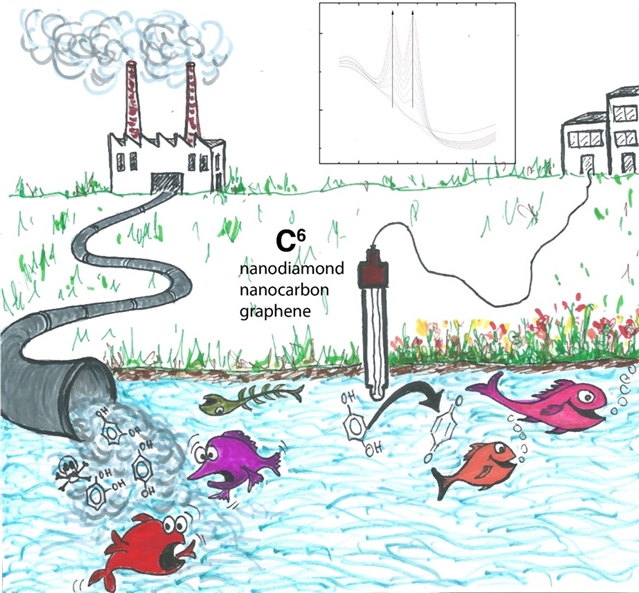论文标题:Nanocarbon and nanodiamond for high performance phenolics sensing
期刊:Communications Chemistry
作者:Luyun Jiang, Ibon Santiago & John Foord
发表时间:2018/08/06
数字识别码:10.1038/s42004-018-0045-8
原文链接:https://www.nature.com/articles/s42004-018-0045-8?utm_source=Other_website&utm_medium=Website_links&utm_content=RenLi-MixedBrand-multijournal-Multidisciplinary-China&utm_campaign=ORG_USG_JRCN_RL_article_promotion_sciencenet_Sep_2ed
酚类化合物是人类健康的一大威胁,主要来源于现代工业生产中的添加物。如何减小酚类化合物的影响首先取决于是否有高效快速的检测手段。电化学检测是最快速有效的方法之一,但是并不完全适用于酚类化合物:一则因为传感器表面非常容易被污染,从而失去活性;二来共存异构体往往同时存在于污染物中,难以区分。
牛津大学的研究人员Dr. Jiang, Dr. Santiago和Prof. Foord, 最近在《通讯 - 化学》上发表的一篇论文Nanocarbon and nanodiamond for high performance phenolics sensing为酚类化合物的检测提供了几点新的思路。他们系统地研究了主流的三种碳材料:石墨烯(sp2杂化),纳米金刚石(sp3 杂化)和纳米碳(sp2+sp3),用于检测苯酚类和二苯酚类等四种不同的酚类化合物。结果表明,虽然石墨烯和纳米碳电极依然有严重的失活问题,但是纳米金刚石电极对于酚类物质检测的稳定性非常强。这是由于sp3杂化的金刚石有很好的化学惰性。这是首个利用纳米金刚石的超强稳定性检测酚类物质的报道。
同时,他们用分散纳米金刚石的方法制备出4-8 nm的超小颗粒纳米碳。由于该材料具有超强的表面吸附能力,传感器灵敏度比同类电极高一个数量级。他们发现每次制备的新电极之间的可重复性非常高,原因是新方法制备出的纳米碳高度均匀分散。为了避免电极的失活问题,他们尝试将电极制备成一次性检测装置,取得了很好的效果。他们的实验还发现纳米碳传感器可以有效分离共存异构体,达到高效的同步检测。
他们进一步将这种纳米碳的一次性检测仪用于检测绿茶里面的酚含量和泰晤士河的污染程度,均取得了理想的结果。这种均匀的纳米碳电化学信号可重复性好,制备方式简单,价格便宜,可以用于制作一次性酚类检测仪,具有很好的工业化前景。

图1:工业生产中排出的酚类物质对于水环境有着重要的影响;本文使用电化学方法(三种不同的碳材料)对水溶液中的酚类物质含量进行高效检测。图中插图为同步检测酚类物质的共存异构体,不同物质互相之间干扰很小
摘要:Phenolic compounds are pollutants of major concern, and effective monitoring is essential to reduce exposure. Electrochemical sensors offer rapid and accurate detection of phenols but suffer from two main shortcomings preventing their widespread use: electrode fouling and signal interference from co-existing isomers. Here we demonstrate a potential solution based on environmentally friendly and biocompatible carbon nanomaterials to detect monophenols (phenol and cresol) and biphenols (hydroquinone and catechol). Electrode fouling is tackled in two ways: by introducing electrochemically resistant nanodiamond electrodes and by developing single-use nanocarbon electrodes. We provide a comprehensive analysis of the electrochemical performance of three distinct carbon materials (graphene, nanodiamond and nanocarbon). Nanocarbon exhibits the lowest detection limit below 10−8M, and one order of magnitude higher sensitivity than the other carbon nanomaterials. We detect co-existing phenol isomers with nanocarbon electrodes and apply it in river water and green tea samples, which may pave the way towards low-cost industrial scale monitoring of phenolic compounds.
阅读论文全文请访问:https://www.nature.com/articles/s42004-018-0045-8?utm_source=Other_website&utm_medium=Website_links&utm_content=RenLi-MixedBrand-multijournal-Multidisciplinary-China&utm_campaign=ORG_USG_JRCN_RL_article_promotion_sciencenet_Sep_2ed
期刊介绍:Communications Chemistry is an open access journal from Nature Research publishing high-quality research, reviews and commentary in all areas of the chemical sciences. Research papers published by the journal represent significant advances bringing new chemical insight to a specialized area of research.
(来源:科学网)
特别声明:本文转载仅仅是出于传播信息的需要,并不意味着代表本网站观点或证实其内容的真实性;如其他媒体、网站或个人从本网站转载使用,须保留本网站注明的“来源”,并自负版权等法律责任;作者如果不希望被转载或者联系转载稿费等事宜,请与我们接洽。